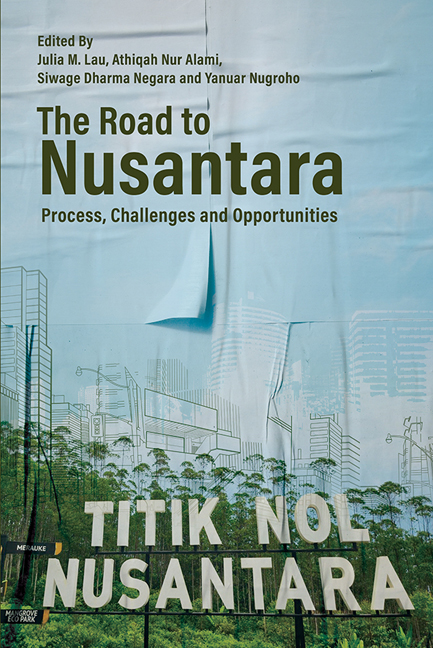Book contents
- Frontmatter
- Contents
- List of Figures
- List of Tables
- Foreword
- Foreword
- The Contributors
- Glossary
- Introduction: The Road to Nusantara—Process, Challenges and Opportunities
- PART I PROCESSES AND PATHWAYS TOWARDS NUSANTARA
- PART II CHALLENGES IN DEVELOPING NUSANTARA
- PART III OPPORTUNITIES FOR NUSANTARA
- Conclusion: Shaping Nusantara
- Index
10 - Sustainability of the Local Community’s Livelihoods and the Idea of the Modern City of Nusantara
Published online by Cambridge University Press: 01 March 2024
- Frontmatter
- Contents
- List of Figures
- List of Tables
- Foreword
- Foreword
- The Contributors
- Glossary
- Introduction: The Road to Nusantara—Process, Challenges and Opportunities
- PART I PROCESSES AND PATHWAYS TOWARDS NUSANTARA
- PART II CHALLENGES IN DEVELOPING NUSANTARA
- PART III OPPORTUNITIES FOR NUSANTARA
- Conclusion: Shaping Nusantara
- Index
Summary
INTRODUCTION
When we first arrived, we felt like we were in hell. We were exiled to the jungle and isolated from the world.
Do we have to repeat the same journey as our old life, even after our territory becomes the National Capital? (SN, interview, 4 July 2022)
Jakarta as Indonesia's capital has a long history of creating the idea of a modern Indonesia. Sukarno, the first president, who had architectural training, dreamed of Jakarta as a city with an ideal society. His speech in 1962 invited Indonesians to dream of an ideal city: one that was not only pleasing to the eye but that also had skyscrapers, wide streets, great monuments, and even housing with a “sense of greatness”. Efforts to realize said ideal modern city have been made by the governors and the central government. Unlike Sukarno, who prioritized the construction of city symbols that reflected grandness and modernity, Ali Sadikin, the governor who was considered the most successful in building Jakarta, made efforts to build better residential areas through the Muhammad Husni Thamrin (MHT) project. However, Jakarta was not built solely by engineers and regional planners with urban planning tools based on Western science (e.g., the zoning system) but also by “individuals and groups who have the authority, capital, vision and will to implement substantial new works, often breaking existing planning rules or avoiding them with the help of higher political authorities, and most importantly, built incrementally by residents”. In its current form, Jakarta is more like a “gigantic Kampung” with “conflicting images” and “conflicting directions”.
Burdened with traffic congestion issues, air pollution, water pollution, and land subsidence to the point where part of it is at risk of sinking, Jakarta can no longer be considered representative of the modern state and people of Indonesia. A new state capital (Ibu Kota Negara, IKN) must be built so that the vision of a developed country can be realized. This is a country that is aware of environmental problems and smart technology, and one that can improve economic development (that is, the Indonesiacentric concept of President Joko Widodo).
- Type
- Chapter
- Information
- The Road to NusantaraProcess, Challenges and Opportunities, pp. 225 - 245Publisher: ISEAS–Yusof Ishak InstitutePrint publication year: 2023



